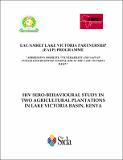| dc.contributor.author | Lake Victoria Basin Commission | |
| dc.date.accessioned | 2015-11-09T14:56:30Z | |
| dc.date.available | 2015-11-09T14:56:30Z | |
| dc.date.issued | 2010 | |
| dc.identifier.citation | HIV&AIDS Baseline Sero-behavioural Study in Two Agricultural Plantations in Lake Victoria Basin, Kenya | en_US |
| dc.identifier.uri | http://repository.eac.int/123456789/683 | |
| dc.description.abstract | The HIV and AIDS pandemic remains a global public health challenge. By the year 2009, an
estimated 33.3 million people were living with HIV and there were 2.6 million new infections
in the same period. Sub-Saharan Africa remains the most affected region, accounting for over
two-thirds of the 33.3 million people living with HIV in 2009 and three-quarters of the HIVrelated
deaths that occurred in the same year. In Kenya, there was a decline in HIV
prevalence from 10% in mid 90s to below 7% in 2009 with an increase in the number of
people receiving antiretroviral treatment. The National AIDS Control Council (NACC),
housed within the Office of the President provides leadership of the national response to
HIV&AIDS by coordinating the multiple sectors. The Ministries of Health (MoH), through
the National AIDS and STI Control Programme (NASCOP) spearhead the interventions on
the fight against HIV/AIDS by coordinating implementation of technical programs. The
Kenya National AIDS Strategic Plan III (KNASP III), covering the period 2009/10 to
2012/13 that was developed by NACC guides the implementation of HIV and AIDS
interventions in Kenya. | en_US |
| dc.description.sponsorship | SIDA | en_US |
| dc.language.iso | en | en_US |
| dc.subject | HIV/AIDS | en_US |
| dc.subject | Agricultural plantations | en_US |
| dc.title | HIV Sero-behavioural Study In Two Agricultural Plantations In Lake Victoria Basin, Kenya | en_US |
| dc.type | Research Paper | en_US |

